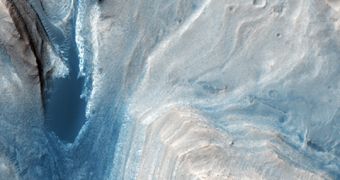As the next NASA mission is scheduled for launch next year, scientists are struggling to choose the best option for a landing site on Mars. So far, they have managed to rule out one more of the suggested sites, thus limiting the options down to just four. The Mars Scientific Laboratory (MSL) rover is supposed to provide additional information on the Martian surface and the main goal is finding a place where life was or still is present or, at least, possible.
The Martian site that was eliminated from the experts' list was the Meridiani Planum area, a region where the Opportunity exploring rover had been scouring for traces of potential past presence of water for almost five years. Among its earliest findings was the proof of an ancient salty, shallow ocean, now gone.
After assessing the risk of endangering the mission, NASA experts now have four sites to choose from, which include the Eberswalde Crater (south of Valles Marineris) – a delta with inverted channels, the Holden Crater (also south of Valles Marineris) – which they think once contained a lake, the Gale Crater (close to Mars' equatorial region) – comprised of clay- and sulphate-filled rock layers which may have been the result of floods or volcanic activity, and the Mawrth Valley (to the north of the other sites) – also clay-filled and potentially containing preserved organic compounds.
"All the sites are great. I wouldn't be dissatisfied with any place that we went," stated for Discovery David Blake, the lead scientist for one of the instruments aboard the MSL. "I think most of the (science) community has kind of evolved into being very interested in studying clays," he added.
The MSL rover will start its long trek to Mars next year and will be deployed on its chosen location sometime during 2010, if all goes well. Its two-year long mission (that is if it does not share the fate of its predecessors, the Spirit and Opportunity rovers and the Phoenix Lander, whose missions were extended for much longer than previously anticipated) will shed new light on the features of our neighboring red planet.

 14 DAY TRIAL //
14 DAY TRIAL //